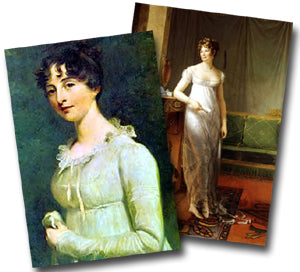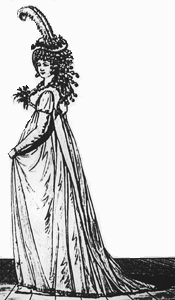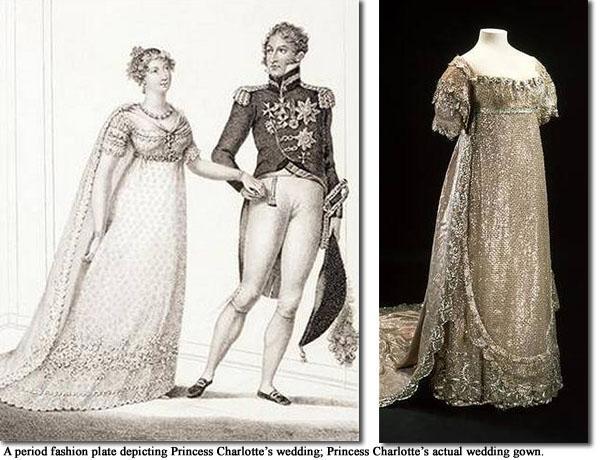Modesty and the Regency Miss
Martha and I dined yesterday at Deane to meet the Powletts and Tom Chute, which we did not fail to do. Mrs. Powlett was at once expensively and nakedly dressed; we have had the satisfaction of estimating her lace and her muslins; and she said too little to afford us much other amusement.
Jane Austen to Cassandra, Steventon, January 8, 1801
Some authors (not to mention book covers) would have you believe that to dress in Regency style was to be overly immodest or even exposed. I beg to differ.  The favorite fabric for a Regency gown was undeniably light-weight, being muslin-a very thin, soft cotton.
The favorite fabric for a Regency gown was undeniably light-weight, being muslin-a very thin, soft cotton.
Yet the Regency lady was no more exposed than she wanted to be. An amusing scene from the 1996 BBC Pride and Prejudice (Starring Jennifer Ehle and Colin Firth) occurs when Lydia has rushed into the hallway wearing only a chemise.
The strait-laced Mr. Collins is forced to pass her on his way to the staircase and is, I believe, clearly scandalized. The scene is quite funny, and Lydia herself cannot stop laughing. But what did he find so shocking? Was it the amount of cleavage in plain sight? Hardly, for a perfectly respectable evening dress could reveal as much. It was more likely the idea of having seen a young lady in her "underclothing" which unsettled poor Mr. Collins.
Half a century earlier, such a sight would likely not have brought the slightest blush to even the most prudish. During the 18th century, women were required to wear layers and layers of clothing consisting largely of underclothes: chemises, stockings, stays (corsets), hoops, panniers, and often many layers of petticoats. By the time of the Regency, costume had undergone a downright shocking reversal causing the heavy layers of underclothing to be discarded.
The change began in France, which in turn was taking its ideas from classical Greek and Roman styles of antiquity. There, women's underclothing was in danger of becoming downright extinct--among the upper class, in particular. When this “Empire Style” crossed the channel into England, however, it became less risque, thanks to the more modest English, but the ideal of a long, straight dress, revealing the human figure beneath had still to be maintained. In short, all those petticoats from the previous century had to go.
The same went for the long corsets, the hoops, the panniers.  What remained was a simple chemise, often accompanied by a short corset which served to raise and support the bust (a precursor to the modern bra), which in turn might be accompanied by a petticoat. This is where personal taste came into play. The long, straight line of the figure was the fashionable ideal and no bulky under-garments could be allowed to get in the way, but ladies could, and did, wear underclothing and the petticoat never disappeared completely from the female wardrobe. The Regency is famous in caricature for the lack of female undergarments, but this propensity of exhibitionism was far less common than the cartoonists' of the day would have you think.
What remained was a simple chemise, often accompanied by a short corset which served to raise and support the bust (a precursor to the modern bra), which in turn might be accompanied by a petticoat. This is where personal taste came into play. The long, straight line of the figure was the fashionable ideal and no bulky under-garments could be allowed to get in the way, but ladies could, and did, wear underclothing and the petticoat never disappeared completely from the female wardrobe. The Regency is famous in caricature for the lack of female undergarments, but this propensity of exhibitionism was far less common than the cartoonists' of the day would have you think.
Most women, like Jane Austen herself, wore sufficient undergarments, and, indeed, dressed quite modestly. The Empire day-dress used sundry manner of textile trickery to conceal the bust (such as frills, lace, ruches, ruffs, and even light spencers) so that day garments were in particular extremely modest. The few who made do without the short corset and petticoat were probably given the most attention by newspapermen simply because they were, well, newspaperMEN! Evening dress was more revealing, requiring a square, low bodice, but women were free to use shawls, scarves, feathers, veils and what-not (all of which came in an amazing array of sizes and styles, especially as the Regency wore on), so that they could easily appear more modestly if they so desired. Even to modern eyes, however, bodices from the day are revealing; but again this was mostly the case for evening wear, and more formal occasions.
The scantily clad lady sitting in the library reading just wasn't the way it went, no matter how romance novel designers choose to portray it ! There have always been people of poor taste, then no less than now. It was they who used the fashion “to an extreme”, who did not wear adequate underclothing, and who, unfortunately, represent the era to some minds. Even drawers were worn by women as early as 1804, (though admittedly not yet popular. They were taken from men's clothing and considered coarse and crude). Princess Charlotte was discovered to use them, however, which (despite shocking the older set), did much to popularize them with the masses, who adored her.
Given a choice between a diaphanous Regency gown complete with a chemise and corset, and today's style of clothing for juniors, I would wager (if I wagered, though I do not!) that the Regency style would be more modest.
Linore Rose Burkard is the author of Before the Season Ends, an Inspirational Regency Romance that readers love. She spent a great deal of time researching the period while writing her book. Coming soon from Harvest House Publishers: a new edition of Before the Season Ends, (Dec. 2008) followed by its sequel, The House in Grosvenor Square.( April, 2009) Visit her website to read more great articles, or to subscribe to her free monthly eZine, "Upon My Word! Facts, Fashion and Figures of the Regency."



1 comment
You are absolutely correct it terms of the strict regency period (1811-1820). Though, even more than the misinformation of romance novels and exaggeration of contemporary cartoonists, I think the confusion might come in terms of the extended concept of the Regency running more or less along-side the Georgian period (1714-1830-7), what we would now consider ‘underwear’ in the form of drawers – never mind chamises or petticoats which are quite sufficient in most cases – only being developed in 1805, leaving a good fifty years without them. There seems to be a conflation of early and late Regency, as there is with later Regency and Victorian, all of the 19th century tending to get lumped together in the popular imagination.
Trevor McNeil
Leave a comment
This site is protected by hCaptcha and the hCaptcha Privacy Policy and Terms of Service apply.